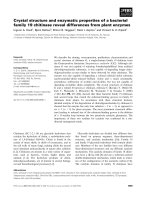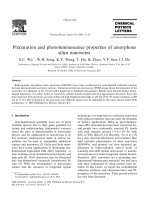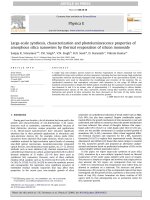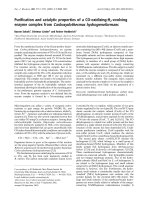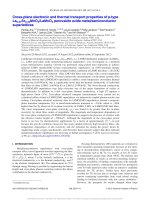Syntheses and photoluminescence properties of new Zn(II) and Cd(II) coordination polymers prepared from 5-sulfoisophthalate ligand
Bạn đang xem bản rút gọn của tài liệu. Xem và tải ngay bản đầy đủ của tài liệu tại đây (5.99 MB, 14 trang )
Turk J Chem
(2017) 41: 243 255
ă ITAK
c TUB
Turkish Journal of Chemistry
/>
doi:10.3906/kim-1604-90
Research Article
Syntheses and photoluminescence properties of new Zn(II) and Cd(II)
coordination polymers prepared from 5-sulfoisophthalate ligand
Fatih SEMERCI˙ ∗
Department of Energy Systems Engineering, Faculty of Technology, Kırklareli University, Kırklareli, Turkey
Received: 28.04.2016
•
Accepted/Published Online: 20.09.2016
ã
Abstract: New coordination polymers, formulated as {[Zn( à -sipH)( µ -apim)] · 3H 2 O}
Final Version: 19.04.2017
n
(1) and {[Cd( µ -sip)(H 2 O) 2
(apimH)] · 3H 2 O} n (2) were synthesized based on the 1-(3-aminopropyl)imidazole (apim) along with 5-sulfoisophthalate
(sip) ligands. The complexes were synthesized under mild hydrothermal conditions. All the complexes were characterized
by elemental analysis, FT-IR spectroscopy, and single-crystal X-ray diffraction studies. The X-ray crystallographic studies
of 1 and 2 reveal Zn(II) and Cd(II) ions are µ -bridged by dianionic sipH and trianionic sip ligands in bis(monodentate)
and bis(bidentate) coordination mode, respectively, to generate 1D polymer chains. In complex 1, the adjacent chains
are linked by two apim ligands to form a 1D nanotubular structure. Complex 2 is the first example of a protonated
apimH ligand. In the complexes the adjacent 1D chains extend into a 3D supramolecular network by hydrogen bonds.
The thermal decomposition behavior and photoluminescent property of the complexes are also discussed herein.
Key words: 5-Sulfoisophthalate complexes, coordination polymer, photoluminescence, thermal analysis, crystal structure
1. Introduction
The synthesis of new coordination polymers is attracting interest, due to their intriguing structural diversities and potential applications in gas adsorption and separation, their catalytic activities, and for sensor
technology. 1−5 Photoluminescent Zn(II) and Cd(II) coordination polymers have recently attracted attention
because of their potential as photoactive materials. 6 Investigations of the photoluminescent properties of coordination polymers with d 10 metal ions reveal that their behaviors are associated with the metal ions and
the organic ligands coordinated with them. 7,8 In addition, photoluminescent d 10 metal complexes have much
more benefits such as higher thermal stability and emitting intensity over organic ligands. 9 These coordination
polymers can be synthesized depending on the combination of metal ions, polycarboxylate, and N-donor connecting ligands. In the synthesis of coordination polymers, conventional synthesis, solvothermal/hydrothermal,
microwave-assisted, sonochemical, electrochemical, and mechanochemical methods have been applied. 10 Among
these methods, solvothermal/hydrothermal synthesis is the most important and common tool to obtain new,
highly robust, and extended coordination polymers in single crystal form. 11,12
5-Sulfoisophthalic acid (sipH 3 ) is one such interesting ligand and has two functional groups, –SO 3 H and
–COOH. Partly or fully deprotonated sipH 2− and sip 3− are useful building blocks for constructing coordination
polymers and act as a versatility ligand and coordinate to metal ions as bridging ligand. 13−16 On the other
∗ Correspondence:
243
˙
SEMERCI/Turk
J Chem
hand, to obtain coordination polymers with interesting structures a useful strategy is to use flexible imidazolecontaining ligands. 17,18 It was reported that 1-(3-aminopropyl)imidazole (apim) as a flexible bridging ligand
that possesses two different types of nitrogen donor, that is imidazole and amine groups, was used to construct
coordination polymers. To date, few examples are reported concerning apim ligands though corresponding
studies are attractive. 19−22
Keeping these facts in mind we used here 5-sulfoisophthalate, which have two carboxylate and sulfo
groups, as a primary ligand and 1-(3-aminopropyl)imidazole as secondary ligand to form coordination polymers with Zn(II) and Cd(II) ions. Their structures were determined by single crystal X-ray diffraction analyses. The crystal structures of these complexes, along with the effect of the 1-(3-aminopropyl)imidazole, 5sulfoisophthalate, and the metal ions on the structure of coordination polymers are discussed herein. In addition,
the thermal analysis and luminescent property of complexes were also investigated.
2. Results and discussion
2.1. Spectral characterization
The complexes were investigated by FT-IR spectroscopy (Figure 1). The presence of water molecules in the
complexes gave rise to broad absorption bands at 3406 and 3418 cm −1 , respectively. The weak bands observed in
the 3132–2963 cm −1 region are due to aromatic and aliphatic C–H stretching vibrations. The absence of strong
absorption bands around 1720 cm −1 indicates the full deprotonation of carboxylate groups of the NasipH 2
ligand. The most characteristic FT-IR bands of the complexes correspond to the carboxyl group stretching
vibrations. Thus, νasym (OCO) are observed at 1622 and 1568 cm −1 for 1 and 1607 and 1553 cm −1 for 2, and
νsym (OCO) are seen at 1356 cm −1 for 1 and 1437 cm −1 for 2; FT-IR analysis of 5-sulfoisophthalic acid sodium
salt was reported 23 By comparisons of the characteristic carboxylate stretching vibrations of the free ligands
and the synthesized complexes, the characteristic carboxylate stretching vibrations have been replaced. The
separation ∆ν , defined as νasym (OCO) – νsym (OCO), provides practical information on the bonding fashion
of the carboxylate groups. The separation of ∆ν was calculated as 266 cm −1 for 1 and 170 cm −1 for 2. The
frequency separations between the asymmetric and symmetric carboxylate stretching vibrations of complex 1
are higher than 240 cm −1 but those of 2 are lower, which suggests that the carboxylate groups in 1 adopt
monodentate mode whereas those in 2 adopt bidentate mode to coordinate to metal centers in accordance with
the single crystal structure determination of the complexes. 24 The bands at 1268–1128 cm −1 are due to ν (S–O)
stretching vibrations stemming from sulfonate groups.
Luminescent Zn(II) and Cd(II) complexes have been developing rapidly and attracting a lot of attention
over the past few years 25 Owing to the luminescent properties of d 10 complexes, the emission spectra of complex
1 and 2 and its ligand (NasipH 2 ) in the solid state were investigated at room temperature (Figure 2).
NasipH 2 shows luminescence with an emission band maximum at 323 nm upon excitation at 280
nm, which is attributed to the π * → n transition. Complexes 1 and 2 exhibit intense fluorescent emission
bands at 451 nm and 431 nm upon excitation at 339 nm and 344 nm. Therefore, the emission of complexes may be attributed to ligand centered luminescence emission. A similar emission band at 439 nm
for {[Zn(2,3-pymaH)(sip)(H 2 O)] ·H 2 O}
n
(2,3-pyma = 2,3’-(Iminodimethanediyl)dipyridine), 26 425 nm for
[Cd(sip)(Hpip)(H 2 O) 2 ] (pip = piperazine), 27 and 437 nm for {[Cd 1.5 (btrp)(sip)(H 2 O) 2 ]· 2H 2 O}
1,3-bis(1,2,4-triazol-1-yl)propane) have been recently observed.
244
n
(btrp =
˙
SEMERCI/Turk
J Chem
Figure 1. FT-IR spectra of 1 and 2.
Figure 2. Solid-state emission spectra of NasipH 2 , 1, and 2 at room temperature.
Figure 3. The molecular structure of 1 showing the atom numbering scheme. [(i) − x, 1 − y, − z; (ii) − 1 + x, y, z;
(iii) 1 + x, y, z].
245
˙
SEMERCI/Turk
J Chem
2.2. Crystal structures
The relevant crystal data and experimental conditions with the final parameters are summarized in Table 1.
Details of these interaction distances are given in Tables 2 and 3.
Table 1. Crystal data and structure refinement parameters for complexes 1 and 2.
Crystal data
Empirical formula
Formula weight
Crystal system
Space group
a(˚
A)
b(˚
A)
c(˚
A)
α (◦ )
β(◦ )
γ(◦ )
V (˚
A3 )
Z
Dc (g cm−3 )
µ (mm−1 )
θ range (◦ )
Measured refls.
Independent refls.
Rint
S
R1/wR2
∆ρmax /∆ρmin (e˚
A−3 )
1
C14 H21 N3 O10 SZn
488.72
Monoclinic
P21 /c
10.154(3)
17.007(3)
11.223(3)
90.00(2)
93.76(2)
90.00
1934.00
4
1.493
1.42
3.0–28.4
35,074
4821
0.204
1.07
0.120/0.335
2.63/–0.99
2
C14 H25 CdN3 O12 S
571.83
Triclinic
P-1
10.072(7)
10.128(8)
12.637(9)
68.978 (2)
81.360 (2)
64.029 (2)
1081.84 (14)
2
1.755
1.17
3.3–28.4
63,555
5401
0.057
1.05
0.035/0.082
1.01/–0.51
Table 2. Selected bond distances (˚
A) and angles ( ◦ ) , hydrogen-bond parameters, and π · · · π interactions distances
for 1.
Bond lengths (˚
A)
Zn1—N3
2.002 (8)
Zn1—O1
2.004 (6)
Zn1—O4
2.007 (6)
Zn1—N1
2.015 (8)
Angles (◦ )
N3—Zn1—O4
113.1 (3)
O4—Zn1—N1 109.7 (3)
N3—Zn1—O1
108.7 (3)
O1—Zn1—O4 95.2 (3)
N3—Zn1—N1
116.9 (3)
O1—Zn1—N1 111.2 (3)
D–H· · · A
H· · · A (˚
A) D· · · A (˚
A)
D–H· · · A (◦ )
N3-H3A· · · O4
2.45
3.062
125
N3-H3B· · · O1
2.23
3.069
155
C12-H12B· · · O1 2.47
3.424
168
C10-H10· · · O6
2.86
3.770
165
π · · · π interactions distances for complexes for 1 (˚
A)
Cg(I)
Cg(J)
Cg–Cg
Cg(5)i
Cg(5)
4.1202
Symmetry codes: i = 2 – x, –y, 1 – z; Cg(5) = C(2)—C(3)—
C(4)—C(5)—C(6)—C(8)
246
˙
SEMERCI/Turk
J Chem
Table 3. Selected bond distances (˚
A) and angles ( ◦ ) , hydrogen-bond parameters, and π · · · π interactions distances
for 2.
Bond lengths (˚
A)
O4—Cd1i
2.433 (2)
O8—Cd1
2.348 (3)
O3—Cd1i
2.418 (2)
O9—Cd1
2.331 (3)
O1—Cd1
2.277 (2)
N1—Cd1
2.244 (2)
Angles (◦ )
O3ii —Cd1—O4ii
53.72 (6)
O8—Cd1—O3ii 97.57 (9)
ii
O1—Cd1—O4
80.00 (7)
O9—Cd1—O4ii 84.72 (9)
ii
O1—Cd1—O3
132.59 (7)
O9—Cd1—O3ii 83.11 (9)
O1—Cd1—O8
92.15 (9)
O9—Cd1—O8
173.82 (9)
O1—Cd1—O9
82.96 (9)
N1—Cd1—O4ii 141.09 (8)
O8—Cd1—O4ii
90.72 (9)
N1—Cd1—O1
138.91 (8)
N1—Cd1—O3ii
87.88 (8)
N1—Cd1—O8
88.24 (9)
N1—Cd1—O9
97.93 (10)
D–H· · · A
H· · · A (˚
A) D· · · A (˚
A)
D–H· · · A (◦ )
N3—H3A· · · O12
1.90(3)
2.765(5)
163(2)
N3—H3B· · · O8
2.41(3)
3.262(3)
161(2)
N3—H3C· · · O11
2.47(3)
3.2131(3)
141(2)
N3—H3C· · · O9
2.55(3)
3.2771(3)
139(2)
O8—H8B· · · O10
1.91(4)
2.7152(2)
167(2)
O8—H8A· · · O4i
1.88(4)
2.750(3)
178(2)
O12—H12C· · · O0AAii 1.96(3)
2.798(4)
167(2)
O12—H12D· · · O5iii
2.04(3)
2.864(4)
164(2)
iv
O11—H11A· · · O7
2.09(3)
2.889(5)
156 (4)
O11—H11B· · · O2v
1.87(3)
2.720(3)
172(4)
O9—H9A· · · O11
1.99(4)
2.751(4)
173(4)
O9—H9B· · · O3v
1.89(5)
2.701(3)
162(4)
O10—H10A· · · O5vi
2.02(7)
2.786(5)
173(7)
O10—H10B· · · O7
2.10(6)
2.797(5)
167(7)
C9—H9· · · O0AA
2.55(3)
3.3582(3)
152(3)
π · · · π interactions distances for complexes for 2 (˚
A)
Cg(I)
Cg(J)
Cg-Cg
Cg1(vii)
Cg2
4.1672(3)
Cg2(iii)
Cg2
3.5992(3)
Symmetry codes: (i) x, y + 1, z; (ii) x, y − 1, z (iii) –x + 2, −y + 1,
−z + 1; (iv) x − 1, y, z − 1; (v) –x + 1, −y, −z + 1; (vi) x − 1, y, z;
(vii) –x + 1, −y + 1, −z + 1; (viii) –x + 2, −y + 1, −z + 2; Cg1 =
N1—C9—N2—C11—C10; Cg2 = C2—C3—C4—C5—C6—C8.
2.2.1. {[Zn(µ -sipH)( µ -apim)] ·3H 2 O}
n
(1)
The X-ray crystal structure analysis revealed that the complex crystallizes in the monoclinic system, P2 1 /c
space group. The asymmetric unit of {[Zn(µ -sipH)(µ -apim)]· 3H 2 O}
n
(1) consists of a Zn(II) ion, one sipH
ligand, and one apim ligand (Figure 3). The Zn(II) ion is located on a symmetry center and is coordinated by
two oxygen atoms [O1 and O4 i ] from two sipH ligands and two nitrogen atoms [N1 and N3 ii ] from two apim
ligands[(i) = −1 + x, y, z; (ii) = 1 − x, − y, − z ](Scheme). The coordination geometry around the Zn(II)
ion can be described as a slightly distorted tetrahedral. The average Zn–N bond length is 2.008 ˚
A, the Zn–O
bond length is 2.005 ˚
A, and the bond angles around Zn(II) fall in the range of 95.2 (3)–116.9 (3) ◦ (Table 3).
247
˙
SEMERCI/Turk
J Chem
With the coordination of sip ligand by Zn(II) ions the electron density on the benzene ring of the sip ligand
decreases. For this reason, the acidic feature of the sip ligand reduces and the sip ligand is protonated. The
Zn(II) ions are µ -bridged by sipH ligands with carboxylate oxygens to generate the 1D polymer chain structure
of 1 (Figure 4). The adjacent Zn(II) ions are linked by two apim ligands to form the 1D nanotubular structure
of 1. The Zn1 · · · Zn1 ii separation is 7.454 ˚
A, similar to those found in [Zn(SCN) 2 (apim) 2 ] n (˚
A) 22 and
{[Cu(apim) 2 (H 2 O)]· (ClO 4 )2 · CH 3 CN} n . 19 Moreover, the 1D nanotubular structures are connected together
through C–H · · · O, N–H · · ·O hydrogen bonds and π · · · π interactions to form a 3D supramolecular structure
(Figure 5).
Complex 1
Complex 2
Scheme. Coordination modes for the sip and apim ligands in 1 and 2.
Figure 4. 1D chain structure with tubular cavities in 1.
248
˙
SEMERCI/Turk
J Chem
Figure 5. A view of 3D supramolecular structure with tubular channels of 1.
2.2.2. {[Cd( µ -sip)(H 2 O) 2 (apimH)]·3H 2 O}
n
(2)
The X-ray crystallographic analysis shows that 2 crystallizes in the triclinic space group P-1 and has an infinite
1D structure. As shown in Figure 6, a crystallographically independent Cd(II) ion is surrounded by a distorted
pentagonal bipyramidal geometry with four oxygen atoms [O1, O2, O3 i , and O4 i ] from two different sip
ligands, one nitrogen [N1] atom from apim ligands, and two oxygens [O8 and O9] from aqua ligands [(i) =
x, –1 + y, z] (Scheme). Coordination polymers containing seven-coordinated Cd(II) are rarely seen in the
˚, the Cd–N bond length is 2.244 (2) ˚
literature. 28−31 The average Cd–O bond length is 2.361 A
A, and the
bond angles around Cd(II) fall in the range of 53.72 (3)–173.82 (9) ◦ (Table 3). The equatorial plane of the
pentagonal bipyramidal geometry is provided by one nitrogen atom from apim and four oxygen atoms from two
different sip ligands. The axial position is occupied by two oxygen atoms from aqua ligands. The sip ligand is
coordinated to two Cd(II) ions in a bis(bidentate) mode with its four oxygen atoms of the carboxylate groups
˚ [(ii) = 1 – x, –y, 1 – z]. The
to form a 1D coordination polymer chain. The Cd1 · · · Cd1 ii separation is 5.803 A
crystal structure of 2 showed the apim ligand charged to apimH by proton transfer from the carboxylic acid
group of the NasipH 2 during the complexation reaction. The structural properties of metal complexes having
protonated cation ligands have rarely been reported. 32,33 This work is the first example of a sip coordination
polymer having a protonated 1-(3-aminopropyl)imidazolium (apimH) ligand that is coordinated Cd(II) ion in
a monodentate manner.
The crystal packing of the complex is a composite of π · · · π and hydrogen bonding interactions. The
adjacent 1D chains extend into a 3D supramolecular network by N–H· · · O and O–H · · · O hydrogen bonds
(Figures 7 and 8a). Furthermore, there are interchain π · · · π interactions between aromatic rings of two sip
ligands. Sulfate groups attract attention for their interaction with water owing to its high charge density 34 In
2, the adjacent chains interact with each other though water–sulfate bridges by strong hydrogen bonds to form
a 2D layer [O10—H10A · · · O5 vi = 1.96(3), O10—H10B· · · O7 = 2.04(3), O12—H12C · · · O0AA ii = 2.02(7)
249
˙
SEMERCI/Turk
J Chem
Figure 6. The molecular structure of 2 showing the atom numbering scheme. [(i) − x, 1 − y, − z; (ii) − 1 + x, y, z;
(iii) 1 + x, y, z].
Figure 7. A view of 1D structure of 2.
250
˙
SEMERCI/Turk
J Chem
and O12—H12D· · · O5 iii = 2.10(6); (ii) x, y − 1, z (iii) –x + 2, − y + 1, − z + 1; (iv) x − 1, y, z − 1]
(Figures 8a and 8b). The 2D layers are connected together by apimH cations through N–H· · · O interactions
[N3—H3A · · · O12 = 1.90(3), N3—H3B · · ·O8 = 2.41(3), N3—H3C· · · O11 = 2.47(3), and N3—H3C · · · O9 =
2.55(3)] resulting in the 3D supramolecular network (Figure 9). Furthermore, there are also C-H· · · O and
π · · · π interactions between both imidazole ring (Cg1) and sip ligand (Cg2), and benzene rings of sip ligands
(Cg1) [(Cg1 = N1—C9—N2—C11—C10 and Cg2 = C2—C3—C4—C5—C6—C8; Cg1 vii · · · Cg2 = 4.1672(3);
Cg2 iii · · · Cg2 = 3.5992(3)], resulting in a 3D supramolecular network (Figure 9).
Figure 8. Hydrogen bonding motifs in 2 showing the ring patterns (a) R22 (4) , R55 (12) and (b) R44 (12) .
Figure 9. A view of the hydrogen bonded 2D network of 2.
251
˙
SEMERCI/Turk
J Chem
2.3. Thermal analysis
The synthesized complexes are stable in ambient conditions, and thermogravimetric experiments (TG, DTG,
and DTA) were performed to examine their thermal stability. The thermal decomposition of complex 1 occurs
in three stages (Figure 10). The first stage between 122
◦
C and 214
◦
C for 1 corresponds to the endothermic
elimination of three water molecules with an experimental mass loss of 10.36% (calcd. mass loss 11.03%,
DTG max = 182.58
◦
C). There is no weight loss between 214 and 311
◦
C. The second stage between 311 and
◦
448 C is related to the elimination of one apim ligand (DTG max = 396.92 ◦ C, found 25.39%, calcd. 25.61%).
The last stage between 448 and 574 ◦ C is related to the decomposition of sip ligand with exothermic effect
(DTG max = 544.83 ◦ C, found 39.84%, calcd. 38.50%). The total mass loss at 574 ◦ C is 75.59% (calc. 75.14%),
which is consistent with the ZnO and ZnSO 4 mixture as the end product for 1 35,36 The thermal decomposition
of complex 2 occurs in two stages (Figure 11). The weight loss in the temperature range 30–126 ◦ C corresponds
to the loss of five water molecules (DTG max = 74.49
◦
C, weight loss of 17.92%, calcd. 15.75%). There is no
◦
weight loss between 126 and 270 C. The weight loss of 59.53% in the region of 270–583 ◦ C corresponds to the
elimination of one apimH and one sip for 2 (calculated: 61.79% and DTG max = 364.22 and 572.73 ◦ C for 2).
The total mass loss at 583 ◦ C is 77.45% (calc. 77.54%), which is consistent with CdO as the end product for 2.
Figure 10. TG, DTG, and DTA curves of complex 1.
In conclusion, two new coordination polymers were hydrothermally synthesized by utilizing the 1-(3aminopropyl)imidazole (apim) and 5-sulfoisophthalate (sip) ligands. The complexes were characterized by
elemental analysis, FT-IR spectroscopy, photoluminescent spectroscopy, and thermal analysis. Their structures
were determined by single crystal X-ray diffraction technique. In 1, the coordination geometry around the
Zn(II) ion can be described as a distorted tetrahedral, while in 2, the seven-coordinated Cd(II) ion can be
defined as a distorted pentagonal bipyramidal. The Zn(II) centers are linked by sipH ligands to form the 1D
polymer chain structure of 1. The adjacent Zn(II) ions are connected by two apim ligands to form the 1D
nanotubular structure of 1. The Cd(II) ions are bridged by sip ligands to generate 1D coordination polymer in
252
˙
SEMERCI/Turk
J Chem
Figure 11. TG, DTG, and DTA curves of complex 2.
2. Rarely observed water–sulfate bridges play an important role in the supramolecular structure of 2. In the
complex 2, the NH 2 – group of apim ligand is protonated because it is not coordinated to the Cd(II) center;
when it comes to complex 1 the NH 2 – group of apim ligand is coordinated by Zn(II) and therefore the free
SO 3 – group of sipa ligand is protonated. Moreover, complex 2 is the first example of a sip coordination polymer
having protonated 1-(3-aminopropyl)imidazolium (apimH) ligands.
3. Experimental
3.1. Synthesis of complexes
3.1.1. {[Zn(µ -sipH)( µ -apim)] ·3H 2 O}
n
(1)
A mixture of Zn(CH 3 COO) 2 · 2H 2 O (0.20 g; 0.91 mmol), NasipH 2 (0.25 g, 0.93 mmol), apim (0.35 g; 2.80
mmol), ethanol (10 mL), and water (20 mL) was stirred at 50 ◦ C for half an hour. Then the mixture was sealed
in a 50-mL Schott Duran brand glass bottle with a PBT screw cap and heated at 100 ◦ C for 2 days; then it was
cooled to room temperature at the rate of 10 ◦ C/h. Pale yellow crystals of 1 were obtained (yield: 0.25 g, 57%
based on Zn(CH 3 COO) 2 ·2H 2 O). Anal. Calcd for C 14 H 21 N 3 O 10 SZn: C, 34.40; H, 4.33; N, 8.60%. Found: C,
33.43; H, 4.21; N, 9.03%. IR data (KBr, cm −1 ): 3406m, 3315s, 3261s, 3132m, 1622vs, 1568s, 1437w, 1356vs,
1203s, 1099s, 1038s, 771m, 737m, 625s.
3.1.2. {[Cd( µ -sip)(H 2 O) 2 (apimH)]·3H 2 O}
n
(2)
A mixture of Cd(CH 3 COO) 2 · 2H 2 O (0.25 g; 0.94 mmol), NasipH 2 (0.25 g, 0.93 mmol), apim (0.24 g; 1.92
mmol), ethanol (10 mL), and water (20 mL) was stirred at 50 ◦ C for half an hour. Then the mixture was sealed
in a 50-mL Schott Duran brand glass bottle with a PBT screw cap and heated at 100 ◦ C for 2 days; then it was
cooled to room temperature at the rate of 10 ◦ C/h. Colorless crystals of 2 were obtained (yield: 0.25 g, 57%
based on Cd(CH 3 COO) 2 · 2H 2 O). Anal. Calcd for C 14 H 25 CdN 3 O 12 S: C, 29.41; H, 4.41; N, 7.35%. Found: C,
253
˙
SEMERCI/Turk
J Chem
30.27; H, 4.66; N, 7.43%. IR data (KBr, cm −1 ): ν 3418m, 3265s, 3130m, 2963w, 1607vs, 1553s, 1437w, 1367vs,
1202s, 1109m, 1042s, 773w, 733m, 627m.
3.2. Materials and measurements
All chemicals were commercially available and used without further purification. Elemental analyses (C, H,
and N) were performed on a PerkinElmer 2400C Elemental Analyzer. IR spectra were recorded on a Bruker
Tensor 27 FT-IR spectrometer using KBr pellets in the range of 400–4000 cm −1 . Thermal analyses (TG, DTG,
and DTA) were carried out with a PerkinElmer Diamond TG/DTA Thermal Analyzer in static air atmosphere
with a heating rate of 10
◦
C/min in the temperature range of 30–700
◦
C. The photoluminescence (excitation
and emission) spectrum for the solid complexes sample was determined with a PerkinElmer LS-55 Fluorescence
spectrometer.
3.3. Crystallographic analyses
Suitable crystals of 1 and 2 were selected for data collections, which were performed on a Bruker D8-QUEST
diffractometer equipped with graphite-monochromatic Mo-Kα radiation at 296 K. The structures were solved
by direct methods using the programs OLEX2 37 and SHELXS-97 38 with anisotropic thermal parameters for all
nonhydrogen atoms. All nonhydrogen atoms were refined anisotropically by full-matrix least-squares methods
in SHELXL-97. 38 In complex 1, a reasonable structural method could not be found for determination of three
noncoordinating water molecules and so the data were corrected by applying the “solvent mask” in OLEX2 37
Molecular drawings were obtained using MERCURY. 39
Acknowledgments
ă
This work has been supported by Kırklareli University (project no: KLUBAP-71).
Dr Semerci acknowledges
the Scientific and Technological Research Application and Research Center, Sinop University, Turkey, for the
use of the Bruker D8-QUEST diffractometer.
References
1. Li, J. R.; Kuppler, R. J.; Zhou, H. C. Chem. Soc. Rev. 2009, 38, 1477-1504.
2. Arıcı, M.; Ye¸silel, O. Z.; Ta¸s, M.; Demiral, H. Inorg. Chem. 2015, 54, 11283-11291.
3. Arıcı, M.; Ye¸silel, O. Z.; Ta¸s, M. Dalton Trans. 2015, 44, 1627-1635.
4. Semerci, F.; Ye¸silel, O. Z.; Soylu, M. S.; Keskin, S.; Bă
uyă
ukgă
ungă
or, O. Polyhedron 2013, 50, 314-320.
5. Lee, J.; Farha, O. K.; Roberts, J.; Scheidt, K. A.; Nguyen, S. T.; Hupp, J. T. Chem. Soc. Rev. 2009, 38, 1450-1459.
6. Cui, Y.; Yue, Y.; Qian, G.; Chen, B. Chem. Rev. 2012, 112, 1126-1162.
7. Erer, H.; Ye¸silel, O. Z.; Arıcı, M. Cryst. Growth Des. 2015, 15, 3201-3211.
8. Semerci, F.; Yeásilel, O. Z.; Yă
uksel, F.; S
á ahin, O. Polyhedron 2016, 111, 1-10.
9. Semerci, F.; Ye¸silel, O. Z.; Yă
uksel, F. Polyhedron 2015, 102, 1-7.
10. Lee, Y. R.; Kim, J.; Ahn, W. S. Korean J. Chem. Eng. 2013, 30, 1667-1680.
11. Ay, B.; Karaca, S.; Yıldız, E.; Lopez, V.; Nanao, M. H.; Zubieta, J. J. Solid State Chem. 2016, 233, 415-421.
12. Semerci, F.; Yeásilel, O. Z.; Yă
uksel, F.; S
á ahin, O. Inorg. Chem. Commun. 2015, 62, 29-33.
13. Allan, P. K.; Xiao, B.; Teat, S. J.; Knight, J. W.; Morris, R. E. J. Am. Chem. Soc. 2010, 132, 3605-3611.
254
˙
SEMERCI/Turk
J Chem
14. Liu, Q. Y.; Yuan, D. Q.; Xu, L. Cryst. Growth Des. 2007, 7, 1832-1843.
15. Kulynych, A. D.; Shimizu, G. K. H. CrystEngComm 2002, 4, 102-105.
16. Voda, I.; Turta, C.; Lozan, V.; Benniston, A. C.; Baisch, U. Polyhedron 2014, 67, 301-305.
17. Tian, L.; Niu, Z.; Yang, N.; Zou, J. Y. Inorg. Chim. Acta 2011, 370, 230-235.
18. Arıcı, M.; Ye¸silel, O. Z.; Ta¸s, M. Cryst. Growth Des. 2015, 15, 3024-3031.
19. Qi, Z. P.; Li, P. Y.; Chen, L.; Li, C. J.; Liu, W. B.; Cheng, X.; Kang, Z. H. Z. Anorg. Allg. Chem. 2013, 639,
424-429.
20. Qian, H. F.; Dai, Y.; Geng, J.; Wang, L.; Wang, C.; Huang, W. Polyhedron 2014, 67, 314-320.
21. Rowan, R.; Tallon, T.; Sheahan, A. M.; Curran, R.; McCann, M.; Kavanagh, K.; Devereux, M.; McKee, V.
Polyhedron 2006, 25, 1771-1778.
22. Arnold, U.; Walter, O.; Dă
oring, M. Inorg. Chim. Acta 2006, 359, 327-333.
23. Videnova-Adrabinska, V.; Nowak, A. M.; Wilk, M.; Janczak, J.; Baran, J. J. Mol. Struct. 2011, 996, 53-63.
24. Deacon, G. B.; Phillips, R. J. Coord. Chem. Rev. 1980, 33, 227-250.
25. Cui, Y. J.; Yue, Y. F.; Qian, G. D.; Chen, B. L. Chem. Rev. 2012, 112, 1126-1162.
26. Xi, P. M.; Wang, S. S.; Gao, D. Z.; Wang, X. G.; Sun, Y. Q.; Zhang, G. Y.; Xu, Y. Y. Transit. Metal Chem. 2013,
38, 873-881.
27. Liu, Q. Y.; Xu, L. Inorg. Chem. Commun. 2005, 8, 401-405.
28. Li, C. P.; Du, M. Inorg. Chem. Commun. 2011, 14, 502-513.
29. Sezer, G. G.; Ye¸silel, O. Z.; Erer, H.; S
¸ ahin, O. J. Solid State Chem. 2016, 233, 463-470.
30. Du, M.; Jiang, X. J.; Zhao, X. J. Inorg. Chem. Commun. 2006, 9, 1199-1203.
31. Mendoza-D´ıaz, G.; Rigotti, G.; Piro, O. E.; Sileo, E. E. Polyhedron 2005, 24, 777-783.
ă
32. Semerci, F.; Yeásilel, O. Z.; Olmez,
H.; Bă
uyă
ukgă
ungă
or, O. Inorg. Chim. Acta 2014, 409, 407-417.
Refat, M. S.; Ishida, H. Polyhedron 2010, 29, 2345-2351.
33. Ye¸silel, O. Z.; Ilker,
I.;
34. Jose, D. A.; Kumar, D. K.; Ganguly, B.; Das, A. Inorg. Chem. 2007, 46, 5817-5819.
35. Zhu, Y. L.; Tang, X. L.; Ma, K. R.; Chen, H.; Ma, F.; Zhao, L. H. Bull. Korean Chem. Soc. 2010, 31, 1881-1886.
36. Straszko, J.; Olszak-Humienik, M.; Mo˙zejko, J. Thermochim. Acta 1997, 292, 145-150.
37. Dolomanov, O. V.; Bourhis, L. J.; Gildea, R. J.; Howard, J. A. K.; Puschmann, H. J. Appl. Crystallogr. 2009, 42,
339-341.
38. Sheldrick, G. Acta Crystallogr. A 2008, 64, 112-122.
39. Macrae, C. F.; Edgington, P. R.; McCabe, P.; Pidcock, E.; Shields, G. P.; Taylor, R.; Towler, M.; Van de Streek,
J. J. Appl. Crystallogr. 2006, 39, 453-457.
255
˙
SEMERCI/Turk
J Chem
Appendix A. Supplementary data
CCDC 1463769 and 1463768 contain the supplementary crystallographic data for 1 and 2. These data can
be obtained free of charge via or from the Cambridge Crystallographic Data Centre, 12 Union Road, Cambridge CB2 1EZ, UK; fax: +44 1223 336 033; or e-mail:
1

